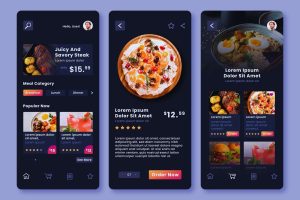The restaurant industry is undergoing one of its greatest revolutions. The days when a good physical menu and friendly service were enough are long gone. Today, digital transformation in restaurants is an urgent necessity—an evolution that goes far beyond a simple QR code.
What Does Digital Transformation Mean for Your Restaurant?
Digital transformation isn’t just about implementing technology; it’s a fundamental change in how you operate and connect with your customers. It means integrating technology into every aspect of your business—from internal management to the customer dining experience. For a restaurant, this means optimizing processes, personalizing service, improving online visibility, and ultimately increasing profitability.
The benefits are tangible:
- Greater operational efficiency: Reduce errors, optimize staff and service times.
- Improved customer experience: Offer convenience, personalization, and a smoother experience.
- Data-driven decisions: Gain valuable insights into customer behavior and business performance.
- Wider reach and visibility: Attract more customers through digital channels.
- Increased profitability: Boost sales and reduce costs.
- Competitive differentiation: Stand out in a crowded market.
1. The Digital Menu: Your First Mandatory Stop
One of the most visible and first steps in digital transformation is digitizing your menu. It’s no longer just about post-pandemic hygiene—it’s about convenience and efficiency.
Beyond the QR code:
- Interactive and visual menus: Not just a PDF. They should be easy to navigate, include high-quality photos, appealing descriptions, allergen info, and customization options (e.g., extra toppings).
- Real-time updates: Instantly change prices, mark items as “sold out,” or add daily specials. This helps reduce waste and customer frustration.
- Mobile optimization: The menu must display perfectly on any device—most customers will view it on their phones.
- Ordering and payment integration: The logical next step is enabling customers to order—and soon pay—directly from the digital menu.
SEO for your digital menu:
Although it may seem obvious, your digital menu is another page on your website and should be optimized.
- Friendly URLs: yourdomain.com/main-menu, yourdomain.com/drinks-menu.
- Keywords in descriptions: Use search terms customers would use (e.g., “artisan pepperoni pizza,” “fresh Peruvian ceviche”).
- Optimized images: Compress photos for fast loading and use descriptive alt text (e.g., alt=”photo of Neapolitan Margherita pizza”).
- Schema Markup: Implement the MenuItem or MenuSection schema to help Google understand your menu’s structure.
2. Smart Point of Sale (POS) Systems: The Brain of Your Operation
A modern POS is much more than a cash register. It’s a comprehensive system that centralizes operations—from taking orders to managing inventory.
Key features of a digital POS:
- Simplified ordering: Tablets for waitstaff that send orders directly to the kitchen, reducing mistakes and wait times.
- Real-time inventory management: Track stock, get alerts for low items, and forecast demand.
- Reports and analytics: Detailed sales data, best-selling dishes, peak hours, staff performance, and more. Crucial for decision-making.
- Integration with other systems: Syncs with online reservations, delivery platforms, loyalty programs, and accounting tools.
- Tip and payroll management: Simplifies staff administration.
Impact on SEO and experience:
An efficient POS improves customer experience by reducing wait times and order errors, leading to better online reviews and improved visibility on Google My Business. The insights also help identify top-selling dishes to feature in your SEO strategy.
3. Online Reservations and Table Management: Never Lose a Customer
Relying only on phone reservations is a thing of the past. An online reservation system is a powerful tool to maximize occupancy and improve the customer experience.
Advantages of online reservations:
- 24/7 availability: Customers can book anytime, even outside business hours.
- Fewer calls: Frees up staff to focus on in-house service.
- Optimized table management: Efficiently assign tables, avoid overlaps, and maximize capacity.
- Automatic reminders: Send confirmations and reminders via SMS or email to reduce no-shows.
- Customer data collection: Preferences, special occasions, visit history—all enable a more personalized service.
SEO and visibility with online reservations:
- Google My Business: Link your reservation system directly to your GMB listing so users can book from search results.
- Website: Make your “Reserve” button prominent and easy to find on your homepage.
- Social Media: Share direct booking links in bios and posts.
- Keywords: Optimize for searches like “book a restaurant in [your neighborhood]” or “online reservation [cuisine type] restaurant.”
- Schema Markup: Use ReservationsAction schema to let Google know you offer online booking.
4. Delivery and Takeout Orders: Expanding Your Reach
The pandemic accelerated the rise of delivery and takeout. Today, they are a cornerstone for many restaurants, providing extra revenue and reaching customers beyond your immediate area.
Strategies and platforms:
- Third-party platforms: Rappi, Uber Eats, etc. Convenient for logistics and reach, but come with commission fees.
- In-house ordering system: An option on your website or app gives you more control over the customer experience and data—while avoiding high commissions. Requires your own delivery logistics or pickup team.
- Delivery-optimized menus: Adapt your offerings to ensure meals travel well and maintain quality.
SEO for delivery and takeout:
- Keywords: “order [cuisine type] delivery in [area],” “takeout restaurant [neighborhood],” “delivery [your restaurant name].”
- Google My Business: Ensure your listing shows delivery and pickup options, with direct links to platforms.
- Website: Create a dedicated “Online Orders” or “Delivery” page with all relevant details and links.
- Google Food Ordering: Google allows users to order directly from Search or Maps—ensure your system is integrated.
5. Digital Marketing and Loyalty: Constant Connection with Your Guests
Digital transformation amplifies your marketing strategies and helps build lasting relationships with your customers.
Tools and strategies:
- CRM (Customer Relationship Management): Collect and organize customer data (preferences, order history, birthdays) to personalize offers and communications.
- Email marketing: Send newsletters, exclusive promos, birthday offers, menu updates, and event invites.
- Digital loyalty programs: Forget paper stamp cards. Use apps or POS-integrated systems to let customers earn points, get tiered discounts, or personalized rewards—boosting frequency and lifetime value.
- Marketing automation: Set up welcome emails, “we miss you” messages, or automatic reservation reminders.
- Advanced social media: Use chatbots for customer support, interactive polls, targeted ads, and sentiment analysis to better understand your audience.
Impact on SEO:
A strong loyalty program and CRM mean happier, more loyal customers—resulting in more positive reviews (vital for GMB and local SEO) and powerful word-of-mouth (or “word-of-click”) marketing. More online engagement also sends positive signals to Google about your relevance and popularity.
SEO for Restaurants: H1, Meta Description, and Meta Tags
To ensure this content has the maximum impact on Google search results, here’s the optimization for key elements:
- H1: Digital Transformation in Restaurants: From Physical Menus to Automation
This H1 is clear, specific, and includes the main keywords—”digital transformation in restaurants” and “automation.” It reflects the central theme and proposed evolution. - Meta Description (example):
“Discover how digital transformation in restaurants can revolutionize your business. From physical menus to automation, learn to optimize operations and attract more customers. Complete SEO guide!” - Meta Tags (Keywords):
While less important for ranking today, including relevant keywords remains good practice.
digital transformation restaurants, restaurant automation, digital menu, restaurant POS, online reservations, restaurant delivery, digital marketing for restaurants, customer loyalty, restaurant technology, restaurant optimization, restaurant SEO
The Future is Digital: Embrace Automation
Digital transformation in restaurants is no longer optional—it’s the natural evolution of the food business. From a simple digital menu to complex automation and data analytics systems, each step brings you closer to greater efficiency, a superior customer experience, and—most importantly—dominant positioning on Google.
Getting started may feel overwhelming, but the key lies in gradual, strategic implementation. Choose the tools that best fit your business model and goals. Every investment in technology is an investment in your restaurant’s future and sustainability.
Are you ready to bring your business into the digital age and see how automation helps you serve more than just great food?
At Digisap, we help you develop a tailored SEO and digital marketing strategy so your restaurant becomes the top choice for diners in your area — not your competitors.
Click here to schedule your free consultation and take your restaurant to the next level





